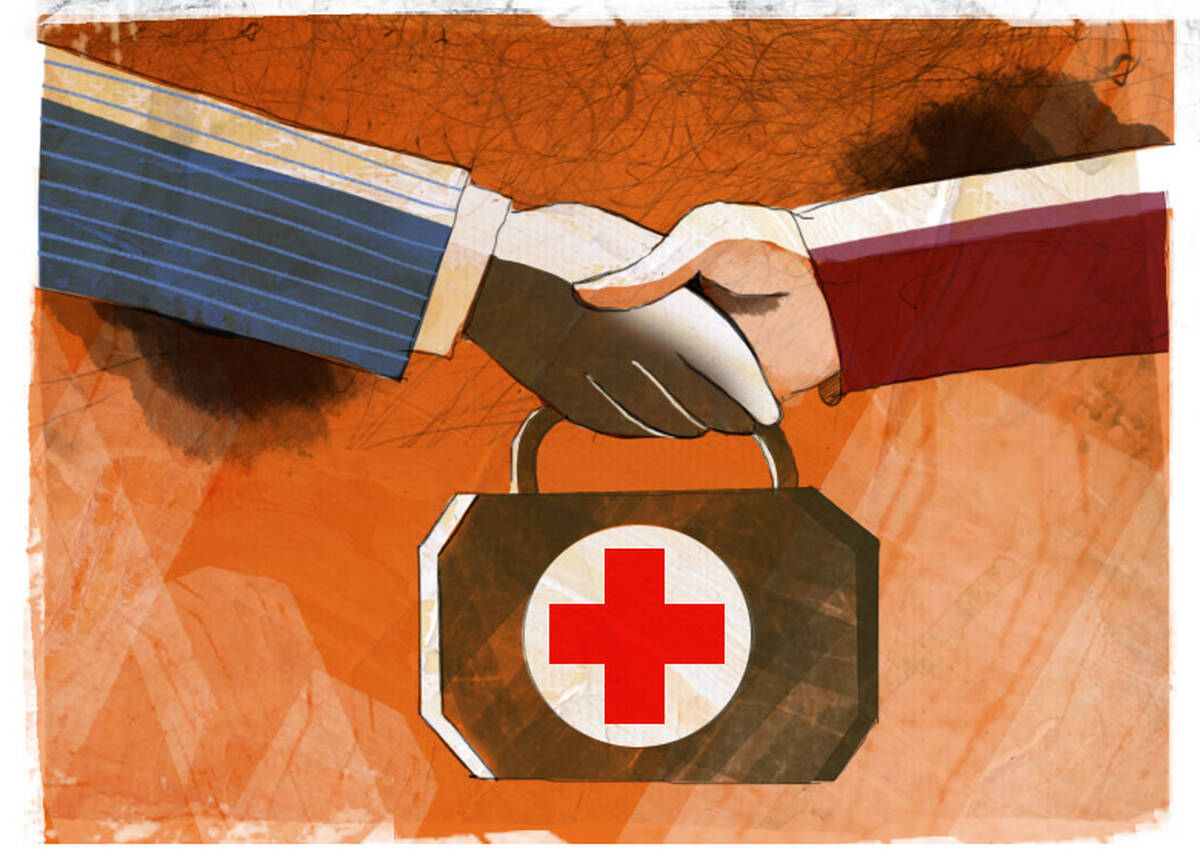She found herself wondering what the implications of this move might be. On the one hand, it was plausible that by offering such high pay, NGOs incentivized workers to perform better, improving life for the individuals they serve while allowing local governments to direct scarce resources elsewhere. Alternatively, it was also possible that those NGOs were siphoning talent away from government services that citizens depend on, but without improving those services.
Deserranno, an associate professor of managerial economics and decision sciences at Kellogg, decided to take a closer look at the impact of NGOs’ entry into small, low-income, rural villages. She partnered on the research project with Nancy Qian, a professor of managerial economics and decision sciences at Kellogg, who had heard similar stories of global aid “crowding out” local services during her time in Rwanda.
In a new study, they find evidence that NGOs can indeed crowd out government-provided services and, in doing so, may inadvertently harm the people they’re seeking to help.
“When I saw the results, I thought, ‘Wow, all of those stories—I guess they’re true!’” says Qian, who is also the founding director of Kellogg’s China Lab. “It’s one thing to hear the stories; it’s another to see them bearing out in the data.”
Deserrano and Qian’s findings suggest that independent organizations may not fully grasp the needs of the communities they serve, leading to adverse consequences. So could NGOs that take a more bottom-up approach have a more positive impact?
That’s the question being investigated in a second new paper from Dean Karlan, codirector of Kellogg’s Global Poverty Research Lab and a professor of economics and finance, and Christopher Udry, codirector of the Global Poverty Research Lab and a professor in the economics department in Northwestern’s Weinberg College of Arts and Sciences. They focused on Ghana’s Eastern Region, where they sought to understand the effects of an NGO development program on existing government institutions and on villagers’ socioeconomic well-being.
Karlan and Udry, too, find that the organization’s arrival led to a kind of crowding out: resources shifted away from existing institutions and into the new NGO, leaving villagers worse off than they were before—with an especially large negative impact on the villagers who supported the government in power.
Given that international NGOs have more than quadrupled in number and in aid administered over the past twenty years, the findings of both papers shed critical light on the complex —and often unintended—consequences of this growth.
However, the researchers remain optimistic that it is possible for NGOs to benefit the communities they serve, if they coordinate with local parties like governments. “There is a plethora of evidence from around the world of NGO programs that have had substantial, positive impact on people’s lives,” Karlan says.
How Does the Arrival of NGOs Affect Health Services?
Deserranno and Qian studied the provision of basic health services in rural Uganda. The country’s infant mortality rates are among the highest in the world and, in recent years, the government has been working to expand access to healthcare.
The Ugandan government began a new program that enlisted volunteer health workers to make home visits to people in their villages. These unpaid workers offer health education, postnatal checkups, basic medical care, and referrals to health clinics when necessary.
Roughly a year later, a large NGO introduced a similar program, in which local villagers provide basic health services door-to-door. There was just one major difference between the government healthcare workers and those with the NGO: the latter would be paid.
This particular NGO generates its funding through the “parallel-task” model, a structure gaining in popularity in the NGO space. In this model, workers both provide free services and sell useful products (like fortified oil, cotton soap, and toothpaste) to the households they visit. By earning its own revenue, the thinking goes, the NGO is able to pay workers while relying less on donors, since workers with the NGO keep a portion of each successful sale they make.
Importantly, just over half of the villages assigned an NGO worker already had a government worker prior to the organization’s arrival. Would the opportunity to make money pull those workers away from government? And if so, what would that mean for health outcomes in those villages?
Putting Participatory Development to the Test
On the other side of the African continent, Karlan and Udry—working with Katharine Baldwin of Yale University and Ernest Appiah of Pentecost University College in Ghana—were interested in studying a different aspect of international development.
They focused their research on an NGO with a much broader set of goals: It aimed to assist villagers in developing their own clinics, rural banks, toilets, food banks, libraries, and more. But unlike many NGOs, this one didn’t just provide financial footing for these services—it also focused on developing leaders and fostering community involvement, to ensure that these services were meeting villagers’ primary needs, and that they would be sustainable.
Residents and local leaders were highly engaged with the NGO, Udry noticed. “When we visited villages just beginning the program, people were excited about the prospect of space for a local clinic, funds for agricultural operations, and the prospect of additional resources from local government,” he says.
In this way, the NGO embodied “participatory development,” the philosophy that outside organizations should help build new, community-run institutions that determine how to distribute aid within an area. By vesting these institutions—rather than the local government—with decision-making power, the participatory development model purports to get around the problem of political favoritism and ensure that aid is distributed fairly.
But Karlan and Udry wondered whether the NGO they studied could live up to these lofty aspirations. While the organization’s nonpartisan stance might empower it to allocate resources fairly and impartially, the researchers worried that it might crowd out important services.
For instance, if political decision-making moved from local government to the NGO, it could lead villagers to participate less in government (by spending less time in government-sponsored community meetings and more time in NGO committee meetings, for example).
The NGO could also crowd out public programs and services. Governments might stop providing services that become redundant once the NGO comes to town. Similarly, many small villages have historically used a system of voluntary, “informal” taxes to fund services from roads to schools to water treatment—but villagers could begin redirecting those payments to the NGO instead.
Such crowding out could have serious implications for the welfare of villagers, for better or for worse. If the NGO used these redirected political and financial resources more effectively than the government had, then the villagers should end up with better programs and services than the government had been providing, leaving them happier and healthier. However, if the NGO did a subpar job, then villagers could be left with mediocre new services and weakened government institutions to fall back on, leaving them worse off.
Moreover, the researchers theorized that the effects of the NGO-sponsored services may not be the same for every villager—and that it might depend on whether a villager was in the same political party as the local government.
Since governments often implement policies that favor members of their own party, villagers who are not members of the ruling party may already benefit less from the government services. So if the NGO successfully improved public institutions, and made them more accessible to everyone, as it aspired to do, then members of nondominant parties—who were previously missing out on public benefits—should be better off.
On the other hand, if the NGO failed to improve public institutions and crowded out government institutions, then everyone would be worse off, with those who had historically relied more on those institutions—members of the dominant party—suffering the most.
In their study, Karlan and Udry zeroed in on roughly 200 villages in Ghana’s Eastern Region, half of which were working with the participatory-development NGO. They tracked governance and socioeconomic changes via two rounds of household, community, and leadership surveys conducted five years apart. These surveys, combined with other data at that household, community, and institutional levels, provided insight into how the NGO’s presence changed resource flows to and from government institutions, and how the NGO affected the socioeconomic well-being of individual households.
Do NGOs Fill Gaps or Reinvent the Wheel?
Both sets of researchers found that the NGOs created unintended negative consequences in the villages they entered, especially when the organization was replicating existing government services.
In Uganda, Deserranno and Qian found that the presence of the NGO produced very different results in villages that had previously had a government health worker versus those with no health worker. In the latter, the arrival of the NGO worker boosted health services and reduced infant mortality.
Among villages that did have a government worker pre-NGO arrival, however, crowd-out was common: the NGO hired away that worker in 39 percent of cases. And when these workers moved over to the NGO, it produced severe consequences for villagers: the likelihood that villagers received care from any health worker declined by 22.9 percent. Strikingly, these villages also experienced an increase in infant mortality after NGO entry.
In total, across all villages, the NGO had zero effect on the provision of health services on average.
Deserranno and Qian theorize that these unfortunate outcomes might in part be attributable to the commercial incentives. Previous research by Deserranno and others have found that while government workers devote an average of 10 hours per week to the delivery of health services, employees at this NGO spend an average of 14 hours per week on the job—but only seven of those hours go to free health services, with the other seven going to sales work.
“The fact that they spend less time on the important task is problematic,” Deserranno says. “This suggests that the NGO may need a different incentive structure. … It’s just unclear at this point what the ideal incentive structure is.” (Indeed, the NGO has since begun experimenting with alternative incentive structures that reward workers for spending time on tasks likely to have larger effects on health.)
Measuring the Real-World Impact of Participatory Development
In Ghana, there was reason for optimism that the participatory development NGO would achieve its lofty goals: In villages that began working with the NGO, Karlan and Udry found that villagers became more likely to attend community meetings and contribute to projects, while trust in leaders and perceptions of accountability also improved. By all accounts, these villages seemed on track to develop better, more equitable public services than peer villages that weren’t assigned to work with the NGO.
However, the boost in civic participation didn’t translate into real socioeconomic outcomes. In fact, after several years, the average person was worse off than they’d been before the NGO arrived.
Overall villager well-being—measured as the overall effects across food security, education, health and nutrition, environment, and economic livelihood—decreased by 0.10 standard deviations after the arrival of the NGO. But villagers who supported the incumbent party fared worst of all, experiencing a dramatic decrease in well-being of 0.43 standard deviations—more than four times the overall average.
What had gone wrong? The researchers found evidence of financial crowding-out.
Government funding decreased by 6.8 percent in the sectors where the NGO was active, even as it increased by 7.4 percent in areas where the NGO was not focused. This indicated that money was flowing away from the government institutions that villagers had previously relied upon and into the new programs and services sponsored by the NGO—yet these new programs and services were less effective at improving people’s well-being.
It’s unclear why the NGO-sponsored programs underperformed so dramatically. One possible theory the authors float: In many developing countries, the national government has more control than local governments over public programs. Thus, by encouraging citizens to “spend … more time engaging with relatively powerless local authorities,” the researchers write, the NGO might have crowded out the kind of higher-level political work that could actually improve well-being.
Karlan notes that the lofty expectations villagers had for the NGO also compounded the disappointing results; had villagers been less eager to trade their existing services for the new ones created by the NGO, there would have been less crowding-out, and so the NGO’s underwhelming performance would have been less painful.
“But you take that high expectation and add under-delivery and, voilà, you get this negative effect,” he says.
The Case for Better Coordination between NGOs and Governments
Despite their discouraging findings, both sets of researchers say that NGOs can still make a positive difference.
“The takeaway here is not at all to avoid funding NGOs,” says Karlan, “but rather to be thoughtful about the risks of crowd-out given the political and institutional realities, and to coordinate with necessary counterparties, such as government, if crowd-out is a risk.”
Better coordination with governments could help NGOs fill important gaps in public services, rather than merely replicating existing services, for example.
That said, Qian notes that it’s the responsibility of governments to make clear where those gaps still exist—something that many governments are failing to do.
“For the most part,” she says, “the governments aren’t collecting data on where their own health workers are. Organizations that have some sway, like the World Bank, need to encourage the collection of data like this on a large scale in poor countries.”
Deserranno notes that governments in several African countries are launching registries for NGOs, which will enable them to coordinate with one another. “It’s hard to think of why the average NGO wouldn’t want to register,” Qian says. “They just wouldn’t have much to lose.”




